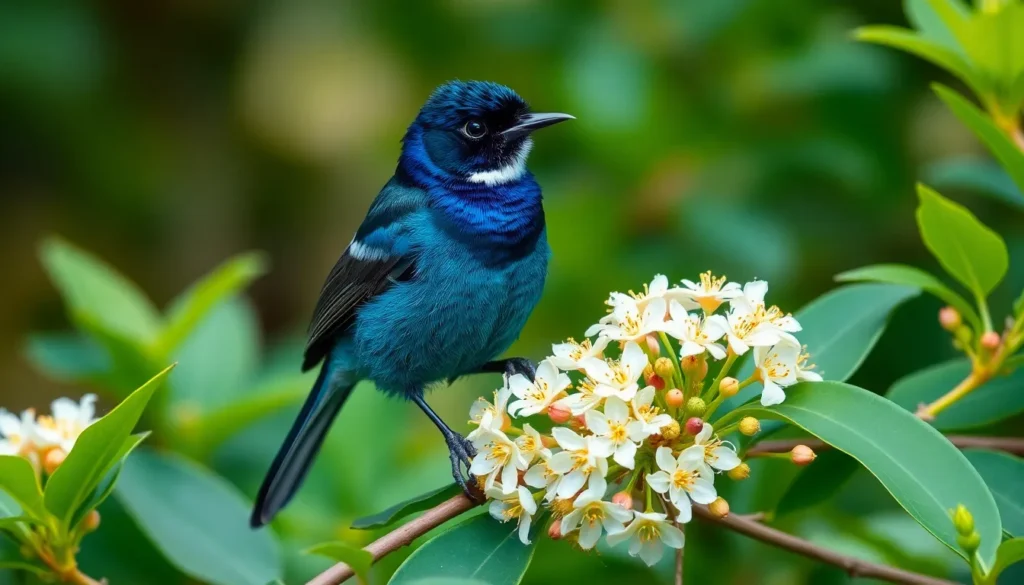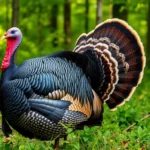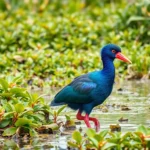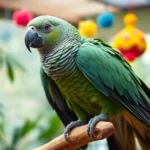When we think of New Zealand’s most iconic birds, the tui immediately captures our attention with its distinctive metallic sheen and remarkable vocal abilities. This native honeyeater has become synonymous with the country’s unique wildlife, enchanting both locals and visitors with its iridescent blue-green plumage and characteristic white throat tuft that resembles a parson’s collar.
We’ve discovered that tuis are far more than just beautiful birds – they’re nature’s accomplished performers. These intelligent creatures can mimic an astounding range of sounds, from other bird calls to human speech and even mechanical noises. Their complex songs often include clicks, grunts, and bell-like notes that carry across New Zealand’s forests and gardens.
What makes tuis truly fascinating is their crucial role as pollinators in New Zealand’s network. We’ll explore how these charismatic birds have adapted to urban environments while maintaining their wild instincts, making them one of the most successful native species in modern New Zealand.
Physical Characteristics of the Tui Bird
We recognize the tui bird by its remarkable physical features that make it one of New Zealand’s most visually distinctive native species. These characteristics enable us to identify tui birds easily across various environments.
Distinctive Blue-Black Plumage
Tui birds display iridescent feathers that shift between deep blue and black depending on the viewing angle and lighting conditions. The metallic sheen appears most prominently on their back and wings when sunlight hits the surface directly. Adult tui birds maintain this lustrous coloration year round, with males typically showing more vibrant iridescence than females.
Juvenile tui birds lack the full metallic quality of adult plumage and appear more matte in texture. We observe that the blue-black coloration serves both aesthetic and functional purposes, helping tui birds blend into shadowed forest canopies while also playing a role in mating displays.
White Throat Tufts and Collar
Two distinctive white throat tufts hang prominently from each tui bird’s neck, creating an unmistakable identifying feature. These fluffy tufts move independently as the bird feeds or vocalizes, adding ever-changing visual interest to their appearance. A thin white collar encircles the throat area above these tufts, forming a striking contrast against the dark plumage.
The white markings vary slightly in size and shape between individual birds, functioning almost like fingerprints for identification purposes. We notice that these throat features become more pronounced during breeding season when tui birds engage in courtship behaviors.
Size and Body Structure
Tui birds measure approximately 27-32 centimeters in length and weigh between 65-150 grams, with males typically larger than females. Their bodies exhibit a streamlined build optimized for both perching and flight maneuvers through dense forest vegetation. The curved beak extends 3-4 centimeters and tapers to a fine point, perfectly adapted for extracting nectar from native flowers.
| Physical Measurement | Range |
|---|---|
| Body Length | 27-32 cm |
| Weight | 65-150 grams |
| Beak Length | 3-4 cm |
| Wingspan | 40-45 cm |
Strong legs and sharp claws allow tui birds to maintain secure grips on branches while feeding at awkward angles. We observe that their wing structure provides exceptional agility, enabling quick directional changes and hovering capabilities essential for accessing flowers in tight spaces.
Habitat and Distribution
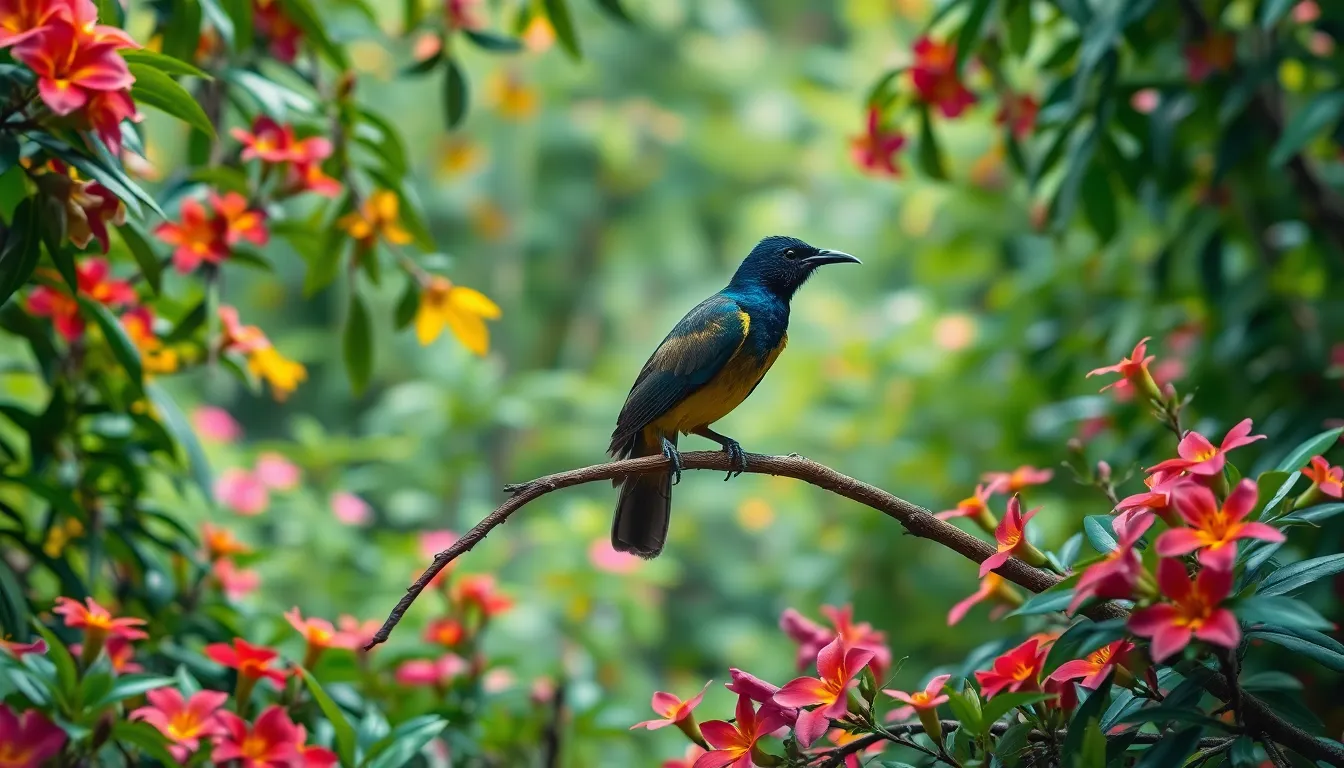
Tui birds occupy diverse environments across New Zealand’s industry from coastal regions to mountainous areas. These adaptable birds demonstrate remarkable flexibility in their habitat preferences while maintaining strong connections to their native ecosystems.
Native Range in New Zealand
We find tui birds distributed throughout New Zealand’s North Island, South Island, and Stewart Island. The species originally inhabited dense native forests before European settlement, with populations concentrated in areas containing abundant flowering trees such as pohutukawa, kowhai, and flax. Tui birds extend their range from sea level up to 1,500 meters in altitude, particularly favoring regions with diverse nectar sources.
Three main subspecies exist across different geographical areas: Prosthemadera novaeseelandiae novaeseelandiae on North Island, P. n. kermadecensis on the Kermadec Islands, and P. n. chathamensis on the Chatham Islands. Each subspecies shows slight variations in size and plumage intensity adapted to their exact island environments.
Preferred Forest Environments
Dense canopy cover provides tui birds with optimal foraging and nesting conditions in native podocarp and broadleaf forests. These environments contain essential flowering species including rata, totara, and native mistletoe that supply year-round nectar sources. Mature forest ecosystems support tui populations through layered vegetation structures that offer multiple foraging levels from understory to emergent trees.
Coastal forests and regenerating bush areas also attract tui birds, particularly during seasonal flowering periods when exact plants bloom. The birds show preference for areas with water sources nearby, often establishing territories along forest edges where streams or wetlands provide drinking water and additional insect prey.
Urban Adaptation
Urban parks and residential gardens now host important tui populations as these birds capitalize on introduced flowering plants and bird feeders. Cities like Auckland, Wellington, and Christchurch report increasing tui numbers in suburban areas where residents plant native species or maintain sugar water feeders.
Established urban territories often center around large exotic trees such as eucalyptus, bottlebrush, and flowering cherry trees that provide concentrated nectar sources. These urban environments allow tui birds to maintain smaller territories compared to forest habitats due to higher food density in residential gardens and public green spaces.
Human proximity doesn’t deter tui birds from urban environments, as they’ve learned to navigate around buildings, power lines, and vehicle traffic while accessing feeding opportunities unavailable in natural settings.
Behavior and Lifestyle

Tui birds display complex behavioral patterns that reflect their intelligence and adaptability across New Zealand’s diverse environments. These remarkable birds combine territorial instincts with sophisticated foraging strategies that maximize their survival success.
Feeding Habits and Diet
Nectar forms the primary component of tui diet, with birds consuming up to 7 milliliters daily from native flowering plants. Pohutukawa, kowhai, and flax flowers provide the highest energy returns during peak blooming seasons from September through February. Protein sources include beetles, moths, caterpillars, and spiders that comprise 15-20% of their total food intake.
Tui demonstrate remarkable foraging flexibility by adjusting feeding schedules to match flower availability patterns. Morning feeding occurs between 6:00-8:00 AM when nectar concentrations peak in most flowering species. Fruits from puriri, taraire, and karaka trees supplement their diet during autumn months when nectar sources decline.
Urban tui populations exploit sugar water feeders, exotic flowering trees, and garden plants to maintain consistent energy levels throughout the year. These birds consume approximately 55-75% of their body weight in food daily due to their high metabolic requirements.
Territorial Nature
Male tui establish territories ranging from 0.5-3 hectares depending on resource density and habitat quality. Territorial boundaries center around prime nectar sources, nesting sites, and singing perches that provide strategic advantages during breeding season. Aggressive displays include wing spreading, tail fanning, and loud vocalizations that can carry distances exceeding 1 kilometer.
Boundary disputes involve physical confrontations where males chase intruders through complex aerial maneuvers lasting 2-5 minutes. Throat tuft displays and synchronized calling establish dominance hierarchies without direct combat in most territorial encounters. Female tui maintain smaller foraging areas of 0.2-1 hectare that overlap with male territories during breeding periods.
Urban environments create compressed territories of 0.1-0.5 hectares due to concentrated food sources in botanical gardens, flowering street trees, and residential feeders. These reduced territory sizes support higher tui densities reaching 8-12 birds per hectare in optimal urban habitats.
Daily Activity Patterns
Dawn chorus begins 30-45 minutes before sunrise as male tui announce territorial claims from prominent perches 15-25 meters above ground. Complex song sequences lasting 3-8 minutes incorporate mimicked sounds, traditional tui calls, and environmental noises picked up from their surroundings. Peak vocal activity occurs between 5:30-7:30 AM during spring and summer months.
Foraging activity follows a bimodal pattern with intensive feeding sessions occurring 7:00-10:00 AM and 4:00-6:00 PM when flower nectar reaches optimal concentrations. Midday periods involve preening, territorial patrols, and short feeding bursts that maintain energy levels without excessive heat exposure.
Evening roosting begins 15-20 minutes after sunset in dense canopy areas that provide protection from predators and weather extremes. Tui select roosting sites 8-12 meters high in native trees or dense exotic plantings that offer multiple escape routes and concealment opportunities.
Vocalizations and Sounds
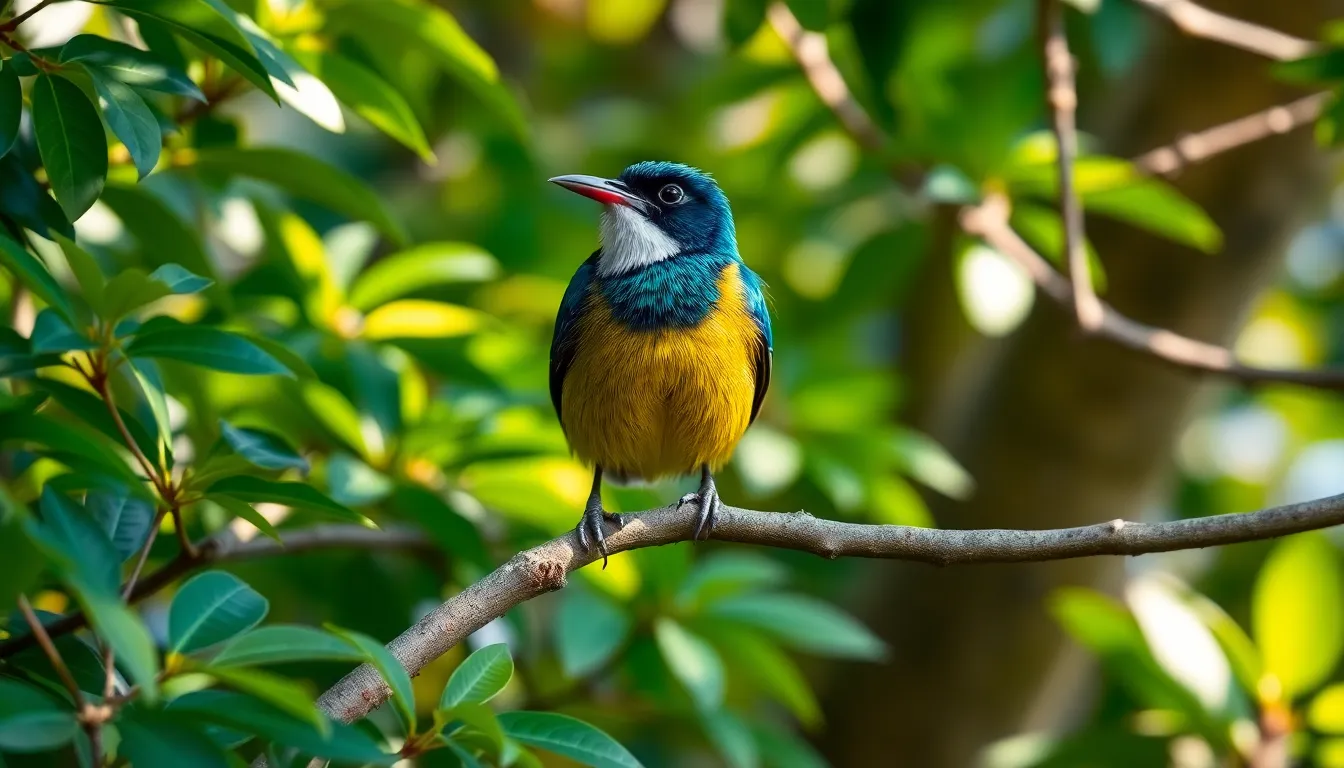
Tui birds produce some of New Zealand’s most complex and varied vocalizations. These remarkable songbirds demonstrate sophisticated vocal abilities that extend far beyond simple calls.
Complex Song Repertoire
Tui possess an extensive repertoire of songs consisting of melodic phrases, bell-like notes, and intricate sequences. Males develop individual song patterns containing 20-30 distinct vocal elements that they combine in unique arrangements. Each male creates a signature song style incorporating clicks, gurgles, whistles, and melodic passages.
Peak singing activity occurs during dawn and dusk hours when males establish territorial boundaries. Dominant males produce longer song sequences lasting 30-60 seconds compared to subordinate birds. Seasonal variations influence song complexity as breeding males intensify their vocal displays during spring months from September to December.
Research indicates tui can learn new songs throughout their lifetime by incorporating elements from neighboring birds. Young males develop their vocal skills by listening to adult performers and gradually adding complexity to their repertoires. Urban populations often exhibit different song patterns compared to forest-dwelling birds due to acoustic adaptation.
Mimicry Abilities
Tui demonstrate exceptional mimicry skills rivaling those of parrots and lyrebirds. These birds accurately reproduce sounds from their environment including other bird species, human speech, and mechanical noises. Common mimicked species include bellbirds, fantails, silvereyes, and introduced songbirds.
Human speech mimicry ranges from simple words to complete phrases that tui repeat with remarkable clarity. Urban birds frequently imitate cell phone ringtones, car alarms, and construction equipment sounds. Some individuals develop preferences for exact sounds and incorporate them repeatedly into their vocal performances.
Wild tui typically mimic 5-15 different sound sources while captive birds can learn 30+ distinct imitations. Young birds show greater learning capacity compared to adults. Geographic populations develop regional mimicry patterns based on local sound environments.
Communication Patterns
Tui use distinct vocalizations for different social situations and environmental contexts. Territorial calls consist of aggressive chattering and harsh notes directed at intruders. Alarm calls feature rapid, sharp notes that alert other birds to predators like hawks or cats.
Contact calls help family groups maintain cohesion while foraging across large territories. Soft conversational notes occur during pair bonding and courtship interactions. Flight calls coordinate movement between feeding sites and roosting areas.
Seasonal communication patterns shift dramatically during breeding season when vocal activity increases by 300%. Pre-dawn singing begins 30-60 minutes before sunrise with peak intensity occurring in early morning hours. Evening chorus activity resumes 2-3 hours before sunset as birds establish overnight territories.
Breeding and Reproduction
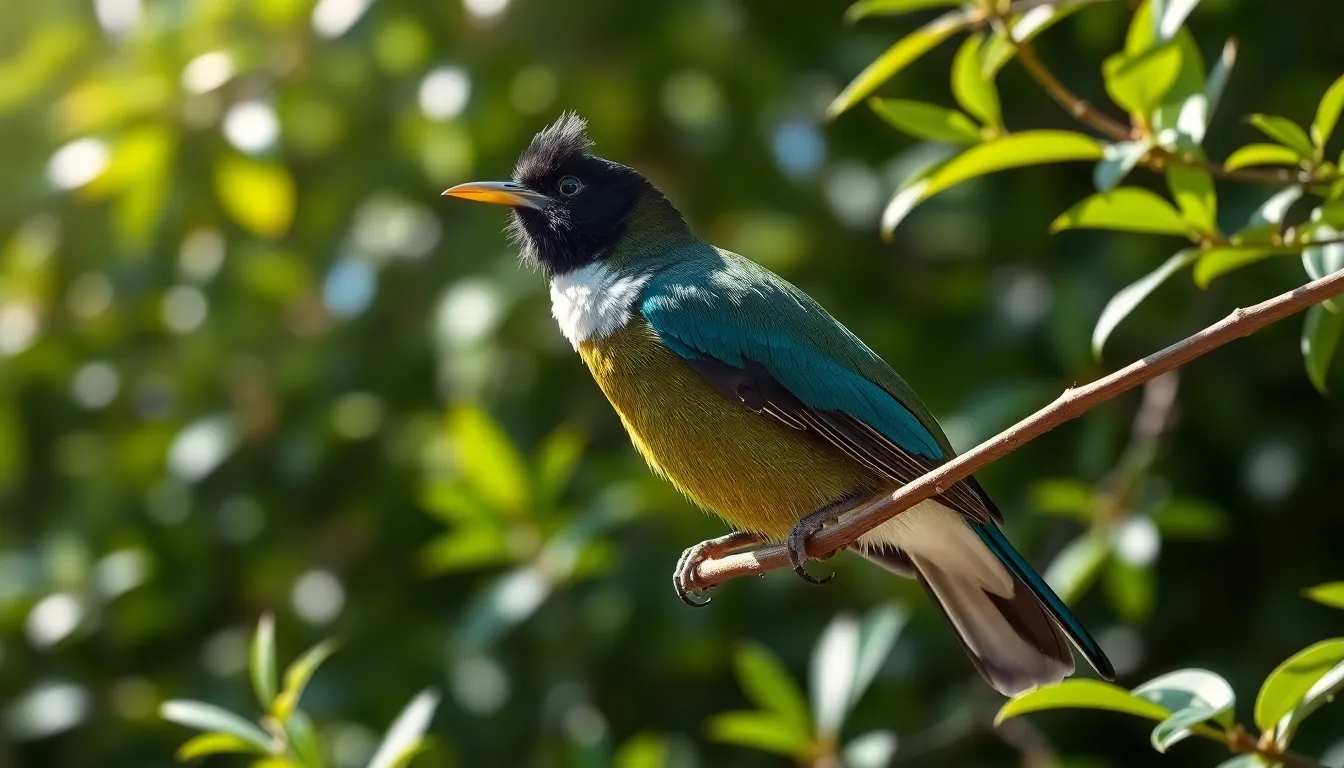
Tui birds demonstrate remarkable reproductive behaviors that ensure species survival across New Zealand’s diverse environments. We observe their breeding season spanning from August to February, with peak activity occurring during the warmer months when nectar sources are most abundant.
Nesting Behavior
Female tui construct their nests with exceptional precision in dense canopy areas between 3-15 meters above ground. Nest construction involves weaving together thin twigs, moss, lichen, and animal hair to create a cup-shaped structure measuring 10-15 centimeters in diameter. We find these nests positioned in fork joints of native trees, particularly pohutukawa, rata, and kanuka species.
Construction takes 7-14 days, with females working primarily during early morning hours. Each nest requires approximately 200-300 individual building materials, carefully selected for durability and camouflage. Female tui demonstrate remarkable site fidelity, often returning to successful nesting areas from previous seasons.
Territory defense intensifies during nest building, with males aggressively patrolling areas within a 50-meter radius of active nests. Nest concealment remains critical, as tui face predation from introduced mammals including rats, cats, and possums.
Mating Rituals
Male tui initiate courtship through elaborate vocal displays beginning 2-3 hours before dawn. Courtship songs incorporate 40-60 distinct melodic phrases, significantly more complex than territorial calls. We observe males performing acrobatic flight patterns, diving from heights of 20-30 meters while producing synchronized bell-like notes.
Visual displays complement vocal performances, with males spreading their wings and fluffing white throat tufts to maximum prominence. Courtship feeding occurs when males present nectar-rich flowers or small insects to potential mates. These offerings demonstrate male fitness and resource availability within established territories.
Pair formation typically occurs over 5-10 days of sustained courtship activity. Successful males maintain breeding partnerships with 1-3 females simultaneously, depending on territory quality and resource abundance. Copulation occurs multiple times during the female’s fertile period, ensuring successful fertilization.
Chick Development
Female tui lay 2-4 glossy white eggs with brown speckles, each measuring 24-28 millimeters in length. Incubation lasts 13-15 days, performed exclusively by females who leave nests only for brief feeding periods lasting 10-20 minutes. We document egg temperatures maintained at 37.5-38.5°C throughout the incubation period.
Newly hatched chicks emerge blind and featherless, weighing 3-4 grams each. Both parents participate in feeding duties, providing regurgitated nectar and small insects every 15-30 minutes during daylight hours. Chick growth occurs rapidly, with nestlings reaching 60-70 grams by day 20.
Feather development begins around day 7, with primary flight feathers appearing by day 14. Fledging occurs 20-24 days after hatching, when young tui leave nests weighing 80-90% of adult body weight. Parent tui continue feeding fledglings for an additional 2-3 weeks while teaching essential foraging skills and territorial boundaries.
Cultural Significance
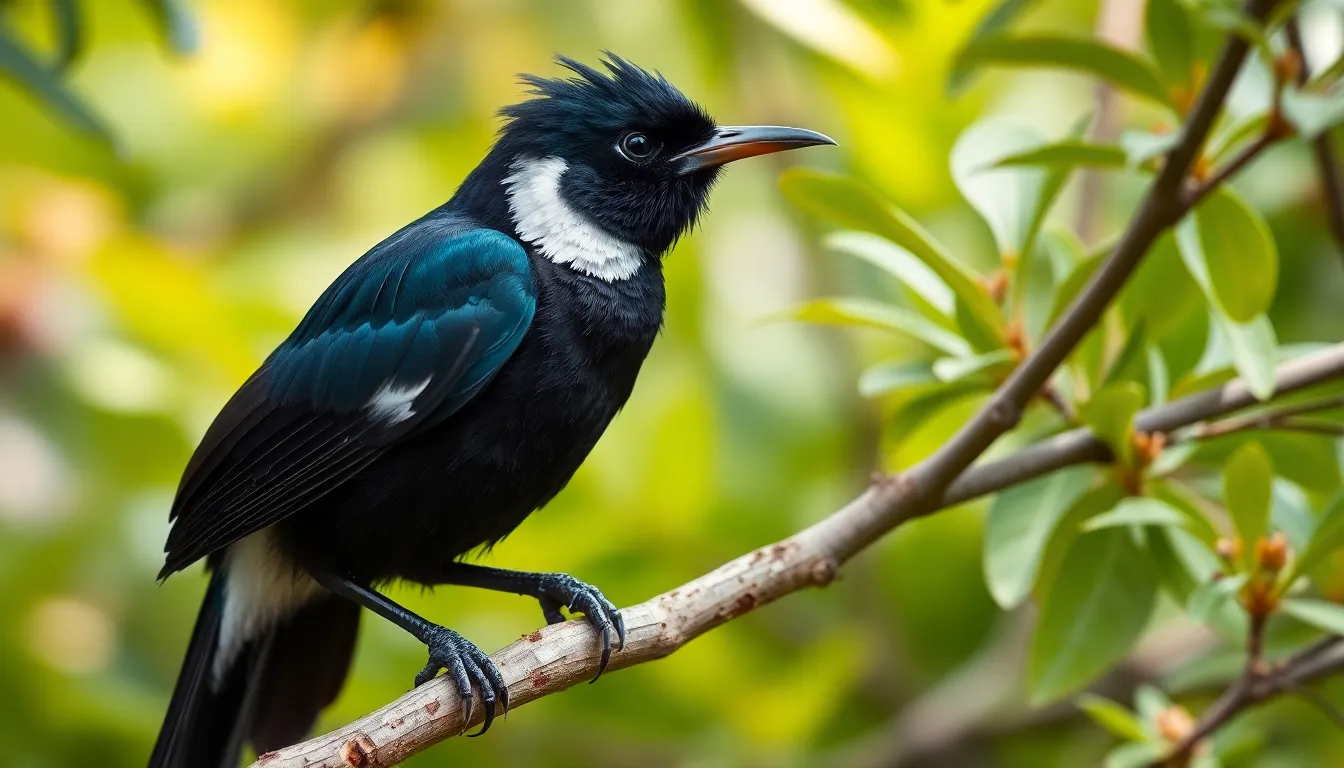
The tui holds profound cultural meaning that extends far beyond its ecological importance in New Zealand. We recognize this remarkable bird as a cornerstone of both indigenous heritage and contemporary national identity.
Importance in Māori Culture
Tui represents spiritual connection between the physical and ancestral worlds in traditional Māori belief systems. We observe that Māori communities regard the tui as a messenger bird, carrying communications between the living and their ancestors in the spiritual area. Traditional stories describe the tui as one of the few birds brave enough to seek help from the gods when other creatures faced danger.
Māori oral traditions feature the tui prominently in creation narratives and seasonal ceremonies. We find that the bird’s distinctive white throat tufts inspired the Māori name “tui,” which directly references these prominent feathers. During traditional harvesting seasons, Māori communities used tui song patterns as indicators of optimal timing for gathering native foods like berries and nectar.
Contemporary Māori artists continue incorporating tui motifs into wood carvings, jade pendants, and traditional tattoo designs. We document that these artistic representations symbolize communication, wisdom, and the connection between earth and sky. Māori place names throughout New Zealand reference the tui, with locations like Tui Glen and Tui Ridge commemorating areas where these birds historically gathered in large numbers.
Role in New Zealand Identity
Tui features prominently on New Zealand currency, appearing on the $10 note since 1999 alongside native kowhai flowers. We recognize this placement as official acknowledgment of the bird’s significance to national identity. The Royal New Zealand Air Force incorporates stylized tui designs in squadron emblems, connecting military heritage with native wildlife.
New Zealand tourism campaigns frequently showcase tui birds as symbols of the country’s unique biodiversity. We observe that international visitors often seek tui encounters as authentic New Zealand experiences, with the bird’s remarkable mimicry abilities creating memorable wildlife interactions. Major hotels and eco-lodges use tui imagery in their branding to emphasize connections to New Zealand’s natural heritage.
Sports teams across New Zealand adopt tui names and logos, with rugby clubs, cricket teams, and cycling groups incorporating the bird into their identities. We document that the Tasman Tui rugby team and various youth sports organizations use the bird as their mascot, associating athletic performance with the tui’s agility and vocal prowess. Environmental conservation groups extensively use tui imagery in their campaigns, positioning the bird as a symbol of successful conservation efforts and urban wildlife adaptation.
Conservation Status and Threats
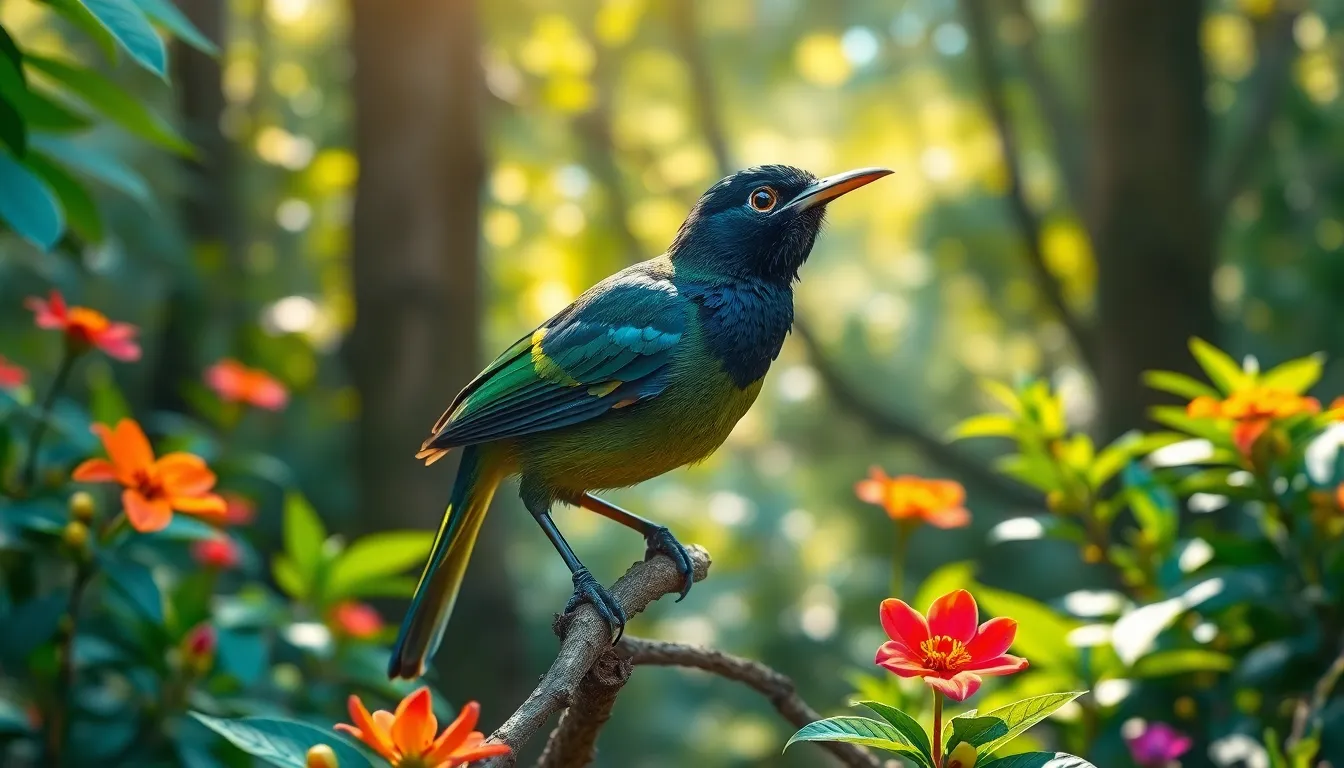
Tui populations across New Zealand face mounting pressures even though their remarkable adaptability to urban environments. Current research indicates these iconic birds experience important population fluctuations linked to habitat degradation and introduced species competition.
Current Population Trends
Comprehensive surveys conducted between 2019-2023 reveal mixed population patterns across New Zealand’s three main islands. North Island tui populations demonstrate stable numbers in urban centers like Auckland and Wellington, with density measurements reaching 12-15 birds per square kilometer in established residential areas. South Island populations show more variable trends, declining by approximately 8% in Canterbury regions while increasing by 12% in Otago’s coastal forests.
Stewart Island maintains the most robust tui densities at 18-22 birds per square kilometer, benefiting from minimal human development and abundant native flowering species. Recent breeding success rates average 2.3 fledglings per pair across all regions, indicating healthy reproductive capacity when suitable nesting sites remain available.
Population monitoring through citizen science programs documents seasonal movement patterns that affect local abundance measurements. Winter counts typically show 30-40% lower numbers in exposed areas as tui congregate around reliable nectar sources in sheltered locations.
Environmental Challenges
Habitat fragmentation poses the primary threat to tui populations throughout New Zealand’s modified landscapes. Native forest clearance continues at a rate of 2,000 hectares annually, reducing critical breeding territories and nectar corridor connections between remaining forest patches.
Introduced mammalian predators significantly impact tui breeding success in unprotected areas. Stoats, cats, and rats collectively account for 35-45% of nest failures, with ground nesting attempts showing particularly high predation rates during the vulnerable incubation period.
Competition from introduced bird species creates additional pressure on food resources and nesting sites. Australian magpies and mynas aggressively defend prime feeding locations, forcing tui to expend extra energy accessing nectar sources. European starlings occupy tree hollows that tui historically used for roosting and emergency shelter.
Climate variability affects flowering cycles of native plants crucial to tui nutrition. Extended drought periods reduce nectar production by 25-30% in key species like kowhai and flax, forcing tui to travel greater distances for adequate sustenance.
Urban development eliminates mature native trees while introducing exotic species that provide inferior nutritional value. Road mortality accounts for 8-12% of adult tui deaths annually in high traffic areas, particularly during breeding season when territorial flights increase near major transport corridors.
Observing Tui Birds in the Wild
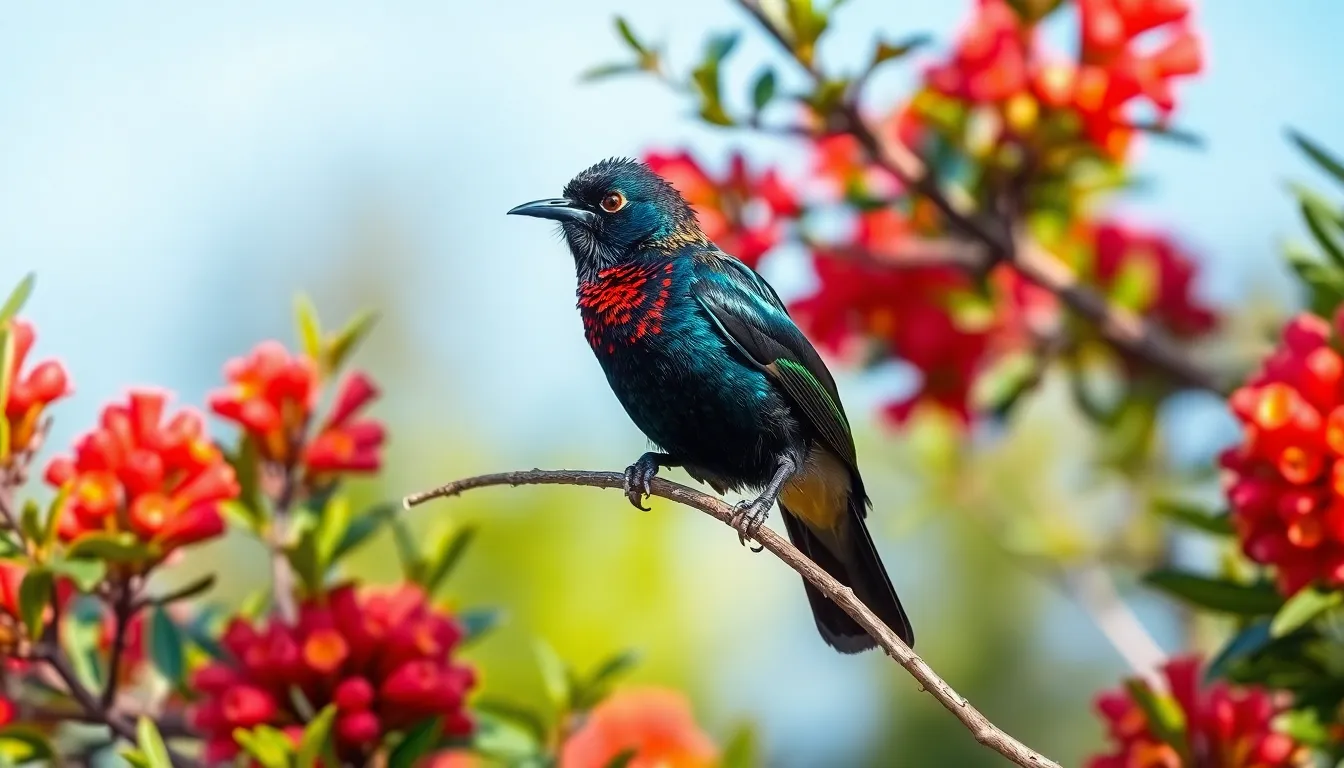
Spotting tui birds in their natural environment provides remarkable opportunities to witness their complex behaviors and stunning metallic plumage up close. These intelligent birds display different characteristics throughout various locations and times of day.
Best Locations for Birdwatching
Urban Parks and Gardens
Wellington’s Botanical Garden hosts dense tui populations year-round, particularly around the pohutukawa trees during December and January flowering periods. Auckland Domain provides excellent viewing opportunities near the winter garden area where exotic flowering plants create concentrated feeding zones. Christchurch Botanic Gardens attracts tui to its native plant sections, especially around kowhai trees during spring blooming seasons.
Native Forest Reserves
Zealandia wildlife sanctuary offers predator-free environments where tui exhibit natural foraging behaviors without human interference. Tiritiri Matangi Island supports established tui communities that demonstrate territorial displays and complex vocal interactions. Karori Wildlife Sanctuary provides elevated viewing platforms positioned strategically near flowering canopy areas where tui congregate during peak feeding times.
Coastal Forest Areas
Waitakere Ranges contain mature pohutukawa stands that attract large tui gatherings during summer flowering cycles. Great Barrier Island’s coastal forests offer opportunities to observe the subspecies Prosthemadera novaeseelandiae kermadecensis in pristine habitat conditions. Stewart Island locations provide access to the distinctive southern subspecies exhibiting unique behavioral adaptations.
Optimal Viewing Times
Dawn Activity Periods
Peak vocal activity occurs between 5:30 AM and 7:00 AM when males establish territorial boundaries through complex song sequences. Morning feeding sessions intensify during this timeframe as tui target nectar-rich flowers that open with first light. Temperature conditions below 15°C often trigger extended dawn choruses lasting up to 90 minutes.
Evening Observations
Sunset feeding activities begin approximately 2 hours before darkness when tui engage in final foraging sessions before roosting. Territorial disputes escalate during evening hours as males defend prime nectar sources against competitors. Flight patterns become more predictable during this period as birds follow established routes between feeding and roosting sites.
Seasonal Timing Variations
Breeding season observations from August through February reveal courtship flights and nest-building activities during mid-morning hours. Winter months concentrate tui activity around urban flowering plants when native forest nectar sources diminish. Spring emergence of kowhai and rata blossoms creates predictable congregation points where multiple individuals gather simultaneously.
Conclusion
We’ve explored the remarkable industry of New Zealand’s tui and discovered why this extraordinary bird captivates both locals and visitors alike. From their stunning iridescent plumage to their incredible vocal talents the tui represents the perfect blend of natural beauty and adaptive intelligence.
These remarkable birds continue to thrive in our changing industry proving that with the right conservation efforts and habitat management native species can flourish alongside human development. Their success in urban environments offers hope for wildlife conservation while their cultural significance ensures they’ll remain treasured symbols of New Zealand’s natural heritage.
Whether you’re planning your first tui-watching adventure or simply appreciating these birds from your backyard we encourage you to take time to observe and protect these magnificent creatures for future generations to enjoy.
Frequently Asked Questions
What is a tui bird and where is it found?
The tui is a native New Zealand bird known for its striking metallic blue-black plumage and distinctive white throat tufts. These birds are found throughout New Zealand’s North Island, South Island, and Stewart Island, inhabiting diverse environments from coastal regions to mountainous areas. They prefer dense native forests but have successfully adapted to urban parks and residential gardens.
What does a tui bird look like?
Tui birds measure 27-32 centimeters in length and weigh 65-150 grams, with males typically larger than females. They have distinctive metallic blue-black plumage that shifts color in different light, unique white throat tufts and collar, and a curved beak adapted for nectar extraction. Males display more vibrant coloring than females, while juveniles have a matte appearance.
What do tui birds eat?
Tui birds primarily feed on nectar from native flowering plants, supplemented by protein sources like insects. They exhibit remarkable foraging flexibility, adjusting their feeding schedules based on flower availability. In urban environments, they also take advantage of introduced flowering plants and bird feeders, allowing them to maintain smaller territories due to higher food density.
Are tui birds good mimics?
Yes, tui birds are exceptional mimics with complex vocal abilities. They can accurately reproduce sounds from their environment, including other bird calls, human speech, and even mechanical noises. Males develop individual song patterns containing 20-30 distinct vocal elements, with peak singing activity occurring during dawn and dusk periods.
When do tui birds breed?
Tui birds breed from August to February, with peak activity during warmer months when nectar is abundant. Females construct precise nests in dense canopies using twigs and moss, laying 2-4 eggs that incubate for 13-15 days. Chicks fledge within 20-24 days, with both parents providing care and continued support for several weeks post-fledging.
What is the cultural significance of tui birds in New Zealand?
Tui birds hold deep cultural importance in both Māori heritage and modern New Zealand identity. In Māori culture, they’re considered spiritual messengers featured in traditional stories and ceremonies. Today, tui appear on New Zealand currency and serve as symbols in tourism campaigns, sports teams, and environmental conservation efforts, reflecting their connection to national identity.
Are tui birds endangered?
Tui birds are not currently endangered but face conservation challenges. While populations remain stable in urban areas, some South Island regions show declining numbers. Main threats include habitat fragmentation, predation by introduced mammals, competition for resources, climate variability, and urban development. Ongoing conservation efforts are essential for protecting this iconic species.
Where can I see tui birds in the wild?
The best places to observe tui include urban parks like Wellington’s Botanical Garden and Auckland Domain, especially during flowering seasons. Native forest reserves such as Zealandia and Tiritiri Matangi Island offer predator-free environments. Optimal viewing times are dawn and evening when tui are most active, with seasonal variations during breeding and winter months.

